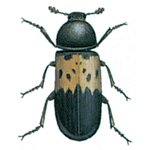
The bacon beetle is part of the dermestid beetles. There are about 25 species of dermestid beetles in Northern Europe. The bacon beetle is one of the best known. Most dermestid beetles feed on various parts of dead animals. They do not belong to the first wave of scavengers, but they arrive later and take advantage of the dry parts of the carrion. The bacon beetle is no exception and it belongs therefore to the group popularly described as “nature’s garbage collectors”, which ensures that carcasses are eaten and become a part of the circle of life.
It is an extremely important deed, but it is also something that can bring the bacon beetle in conflict with people because many of the foods we store correspond to dry carrion in the eyes of these beetles.
The adult bacon beetle (Dermestes lardarius) is 7-9 mm long and easily recognised by the bright band with dark dots that goes across the front of its elytra. The female lays hundreds of eggs, preferably directly in cracks and crevices in food. The larvae grow within 2-3 months, at room temperature, for a length of up to 15 mm. They are clearly articulated with long bristles sticking out from all joints. Visible on the rear part are the two dark chitin hooks.
In cold places, the bacon beetle overwinters as an adult beetle and becomes active again in the spring. The heated rooms is active throughout the year.
The full-grown larvae will usually leave the place they grew up and seek out a sheltered place where they can pupate. If they do not find a suitable spot close by they can chew a cave using their very strong jaws. This little cave is approximately 4 mm in diameter which is suitable for the larval thickness and a few cm. deep, and actually looks like it’s pierced with a 4mm. drill.
Like this they can cause secondary damage to cardboard and wood. This is the explanation as to why bacon beetles are sometimes found in places where they apparently do not belong. They simply gnawed into the packaging that stood near their food.
The bacon beetle used to be a feared pest in many households. It went into winter supplies as dried fish, cheese and smoked goods. Today, as these goods are kept more appropriately, the bacon beetle has only a tiny role in households.
In companies that work with dried fish, hides and dry food the bacon beetle and its close relative the Dermestes haemorrhoidalis still cause problems.
If a single bacon beetle appears in a house, it does not necessarily mean anything. They are active insects, and they fly in nature and can get lost indoors. If there are many, it is a good idea to find out where they come from. A dead mouse under the floor, a couple of dead chicks in a nest in the attic are options as to where the beetles come from. It also happens that they have evolved in a bag of dry dog or cat food containing all the things these beetles like to live in and eat. Foods that are forgotten because of illness or vacation are of course also an option.




